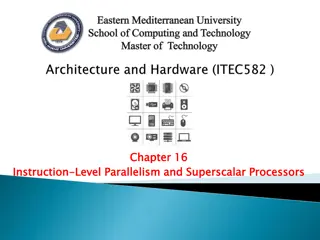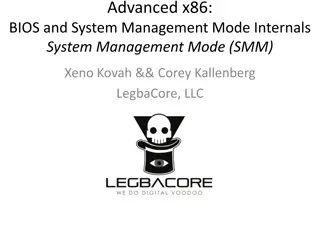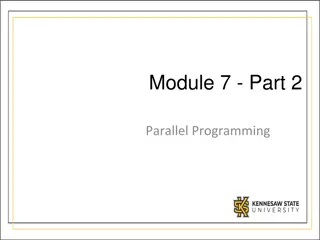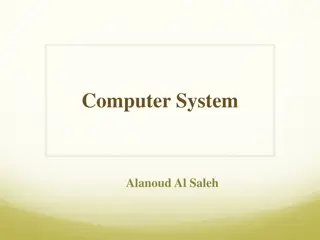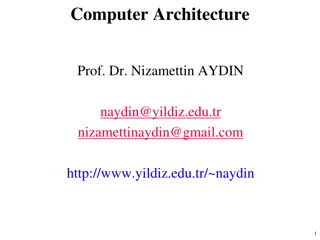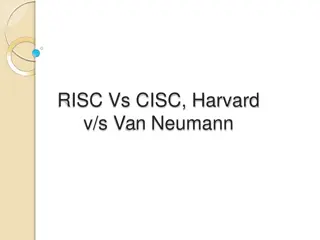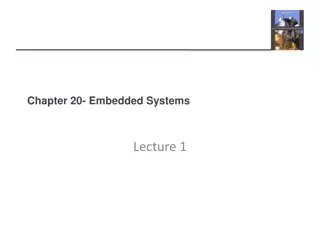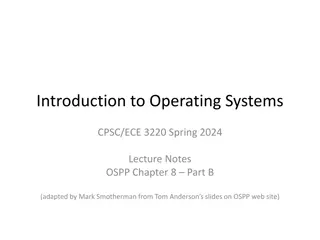Understanding Multicore Processors: Hardware and Software Perspectives
This chapter delves into the realm of multicore processors, shedding light on both hardware and software performance issues associated with these advanced computing systems. Readers will gain insights into the evolving landscape of multicore organization, spanning embedded systems to mainframes. The discussion covers the integration of multiple cores on a single silicon die, memory and peripheral controllers in SoCs, and the challenges and benefits of leveraging multicore architectures in modern computing environments.
- Multicore processors
- Hardware performance
- Software challenges
- Embedded systems
- Performance optimization
Download Presentation

Please find below an Image/Link to download the presentation.
The content on the website is provided AS IS for your information and personal use only. It may not be sold, licensed, or shared on other websites without obtaining consent from the author. Download presentation by click this link. If you encounter any issues during the download, it is possible that the publisher has removed the file from their server.
E N D
Presentation Transcript
Eastern Mediterranean University School of Computing and Technology Master of Technology Chapter 18 Multicore Processors Chapter 18 Multicore Processors
After studying this chapter, you should be able to: Understand the hardware performance issues that have driven the move to multicore computers. Understand the software performance issues posed by the use of multihreaded multicore computers. Present an overview of the two principal approaches to heterogeneous multicore organization. Have an appreciation of the use of multicore organization on embedded systems, PCs and servers, and mainframes. 2
A multicore multiprocessor, combines two or more processors (called cores) on a single piece of silicon (called a die). Typically, each core consists of all of the components of an independent processor, such as registers, ALU, pipeline hardware, and control unit, plus L1 instruction and data caches. In addition to the multiple cores, contemporary multicore chips also include L2 cache and, in some cases, L3 cache. multicore computer, also known as a chip 3
The most highly integrated multicore processors, known as systems on chip (SoCs), also include memory and peripheral controllers. This chapter provides an overview of multicore systems. We begin with a look at the hardware performance factors that led to the development of multicore computers and the software challenges of exploiting the power of a multicore system. Next, we look at multicore organization 4
1.Hardware Performance Issues Microprocessor systems have experienced a steady increase in execution performance for decades. This increase is due to a number of factors; including increase in clock frequency, increase in transistor density, and refinements in the organization of the processor on the chip 5
Increase in Parallelism and Complexity The organizational changes in processor design have primarily been focused on exploiting ILP, so that more work is done in each clock cycle. These changes include; Pipelining: Individual instructions are executed through a pipeline of stages so that while one instruction is executing in one stage of the pipeline, another instruction is executing in another stage of the pipeline Summarize the differences among simple instruction pipelining, superscalar, and simultaneous multithreading 6
Superscalar: Multiple pipelines are constructed by replicating execution resources. This enables parallel execution of instructions in parallel pipelines, so long as hazards are avoided 7
Simultaneous multithreading (SMT): Register banks are expanded so that multiple threads can share the use of pipeline resources 8
Multicore architecture places multiple processor cores and bundles them as a single physical processor. The objective is to create a system that can complete more tasks at the same time, thereby gaining better overall system performance. M Multicore ulticore Organization Organization 9
With each of these innovations, designers have over the years attempted to increase the performance of the system by adding complexity. In the case of pipelining, simple three-stage pipelines were replaced by pipelines with five stages. Intel s Pentium 4 Prescott core had 31 stages for some instructions. With superscalar organization, increased performance can be achieved by increasing the number of parallel pipelines. This increases the difficulty of designing, fabricating, and debugging the chips as the complexity increases. 10
Power Consumption To maintain the trend of higher performance as the number of transistors per chip rises, designers have resorted to more elaborate processor designs (pipelining, superscalar, SMT) and to high clock frequencies. Unfortunately, power requirements have grown exponentially as chip density and clock frequency have risen. One way to control power density is to use more of the chip area for cache memory. Memory transistors are smaller and have a power density an order of magnitude lower than that of logic Why is there a trend toward given an increasing fraction of chip area to cache memory? 11
As chip transistor density has increased, the percentage of chip area devoted to memory has grown, and is now often half the chip area Pollack s rule states that performance increase is roughly proportional to square root of increase in complexity. In other words, if you double the logic in a processor core, then it delivers only 40% more performance. I 12
2. 2. Software Performance Issues Software Performance Issues The potential performance benefits of a multicore organization depend on the abilitity to effectively exploit the parallel resources available to the application. Let us focus first on a single application running on a multicore system. Even a small amount of serial code has a noticeable impact. If only 10% of the code is inherently serial (f = 0.9), running the program on a multicore system with eight processors yields a performance gain of only a factor of 4.7 13
In addition, software typically incurs overhead as a result of communication and distribution of work among multiple processors and as a result of cache coherence overhead. This overhead results in a curve where performance peaks and then begins to degrade because of the increased burden of the overhead of using multiple processors 14
The organization are as follows: The number of core processors on the chip The number of levels of cache memory How cache memory is shared among cores Whether simultaneous multithreading (SMT) is employed The types of cores main variables in a multicore what are the main design variables in a multicore organization? 15
Levels of Cache There are four general organizations for multicore systems. In this organization, the only on-chip cache is L1 cache, with each core having its own dedicated L1 cache, divided into instruction and data caches reasons while L2 and higher caches are unified. It is found in some of the earlier multicore computer chips embedded chips. An example of this organization is the ARM11 MPCore. for performance and still seen in 16
In this, there is enough area available on the chip to allow for L2 cache. An example of this organization is theAMD Opteron 17
The organization for the given figure is a similar allocation of chip space to memory, but with the use of a shared L2 cache. The Intel Core Duo has this organization 18
Finally, a shared L3 cache is used with dedicated L1 and L2 caches for each core processor. The Intel Core i7 is an example of this organization. 19
The use of a shared higher-level cache on the chip has several advantages over exclusive reliance on dedicated caches: It can reduce overall miss rates. The data shared by multiple cores is not replicated at the shared cache level. Inter-core communication is easy to implement, via shared memory locations. It confines the cache coherency problem to the lower cache levels, which may provide some additional performance advantage 20
List some advantages of a shared L2 cache among cores compared to separate dedicated L2 caches for each core. 1. Constructive interference can reduce overall miss rates. That is, if a thread on one core accesses a main memory location, this brings the frame containing the referenced location into the shared cache. If a thread on another core soon thereafter accesses the same memory block, the memory locations will already be available in the shared on-chip cache. 2. A related advantage is that data shared by multiple cores is not replicated at the shared cache level. 21
3. With proper frame replacement algorithms, the amount of shared cache allocated to each core is dynamic, so that threads that have a less locality can employ more cache. 4. Interprocessor communication is easy to implement, via shared memory locations. 5. The use of a shared L2 cache confines the cache coherency problem to the L1 cache level, which may provide some additional performance advantage 22
A potential advantage to having only dedicated L2 caches on the chip is that each core enjoys more rapid access to its private L2 cache. This is advantageous for threads that exhibit strong locality. As both the amount of memory available and the number of cores grow, the use of a shared L3 cache combined with dedicated per core L2 caches seems likely to provide better performance than simply a massive shared L2 cache or very large dedicated L2 caches with no on-chip L3. An example of this latter arrangement is the Xeon E5-2600/4600 chip processor 23
4. 4. Heterogeneous Heterogeneous Multicore Organization Multicore Organization As clock speeds and logic densities increase, designers must balance many design elements in attempts to maximize performance and minimize power consumption. We have so far examined a number of such approaches, including the following: 1. Increase the percentage of the chip devoted to cache memory. 2. Increase the number of levels of cache memory. 3. Change the length (increase or decrease) and functional components of the instruction pipeline. 4. Employ simultaneous multithreading. 5. Use multiple cores 24
A typical case for the use of multiple cores is a chip with multiple identical cores, known as homogenous multicore organization. To achieve better results, in terms of performance and/or power consumption, an increasingly popular design choice is heterogeneous multicore organization, which refers to a processor chip that includes more than one kind of core. Two approaches to heterogeneous multicore organization. (i) Different Instruction SetArchitectures (ii) Equivalent Instruction Set Architectures 25
(i) Different Instruction Set Architectures CPU/GPU multicore : The most prominent trend in terms of heterogeneous multicore design is the use of both CPUs and graphics processing units (GPUs) on the same chip. Briefly, GPUs are characterized by the ability to support thousands of parallel execution threads. Thus, GPUs are well matched to applications that process large amounts of vector and matrix data. 26
Multiple CPUs and GPUs share on-chip resources, such as the last-level cache (LLC), interconnection network, and memory controllers. Most critical is the way in which cache management policies provide effective sharing of the LLC. The differences in cache sensitivity and memory access rate between CPUs and GPUs create significant challenges to the efficient sharing of the LLC 27
Table above illustrates the potential performance benefit of combining CPUs and GPUs for scientific applications. This table shows the basic operating parameters of an AMD chip, the A10 5800K. For floating- point calculations, the CPU s performance at 121.6 GFLOPS is dwarfed by the GPU, which offers 614 GFLOPS to applications that can utilize the resource effectively. 28
The overall objective is to allow programmers to write applications that exploit the serial power of CPUs and the parallel-processing power of GPUs seamlessly with efficient coordination at the OS and hardware level. CPU / DSP multicore Another common example of a heterogeneous multicore chip is a mixture of CPUs and digital signal processors (DSPs). A DSP provides ultra- fast instruction sequences (shift and add; multiply and add), which are commonly used in math- intensive digital signal processing applications 29
DSPs are used to process analog data from sources such as sound, weather satellites, and earthquake monitors. Signals are converted into digital data and analyzed using various algorithms such as Fast Fourier Transform. DSP cores are widely used in myriad devices, including cellphones, sound cards, fax machines, modems, hard disks, and digital TVs 30
(ii) Equivalent Instruction Set Architectures Another recent approach to heterogeneous multicore organization is the use of multiple cores that have equivalent ISAs but vary in performance or power efficiency. The leading example of this is ARM s big.Little architecture, which we examine in this section. 31
Chip containing two high- performance Cortex- A15 cores and two lower performance, lower-power-consuming Cortex-A7 cores. The A7 cores handle less computation-intense tasks, such as background processing, playing music, sending texts, and making phone calls. The A15 cores are invoked for high intensity tasks, such as for video, gaming, and navigation. The big.Little architecture is aimed at the smartphone and tablet market 32
These are devices whose performance demands from users are increasing at a much faster rate than the capacity of batteries or the power savings from semiconductor process advances. The usage pattern for smartphones and tablets is quite dynamic. The A15 is designed for maximum performance within the mobile power budget. The A7 processor is designed for maximum efficiency and high enough performance to address all but the most intense periods of work. 33
Intel Core i7-990X Each core has its own dedicated L2 cache and the six cores share a 12-MB L3 cache. It uses prefetching in which the hardware examines memory access patterns and attempts to fill the caches speculatively with data that s likely to be requested soon. The Core i7-990X chip supports two forms of external communications to other chips. The DDR3 memory controller The QuickPath Interconnect (QPI) 34
The DDR3 memory controller It brings the memory controller for the DDR main memory onto the chip. The interface supports three channels that are 8 bytes wide for a total bus width of 192 bits, for an aggregate data rate of up to 32 GB/s. The QuickPath Interconnect (QPI) It is a cache- coherent, point- to- point linkbased electrical interconnect specification for Intel processors and chipsets. It enables high- speed communications among connected processor chips. The QPI link operates at 6.4 GT/s (transfers per second). At 16 bits per transfer, that adds up to 12.8 GB/s, and since QPI links involve dedicated bidirectional pairs, the total bandwidth is 25.6 GB/s 35
2. Give several reasons for the choice by designers to move to a multicore organization rather than increase parallelism within a single processor. 4. List some examples of applications that benefit directly from the ability to scale throughput with the number of cores. 5. At a top level, 6. 36







